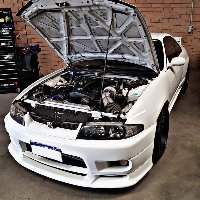liquid cooled brakes
Announcements
-
Similar Content
-
Latest Posts
-
By joshuaho96 · Posted
Wideband is worth setting up if only for tuning purposes. I would not mess with the ignition system unless there's a misfire. HKS crank trigger is popular out here for the relatively easily sourced Denso crank sensor, not a bad idea to install as well regardless of power level on a standalone. Boost leak test is worth thinking about. Oil pressure sensor tied to a fuel cut isn't a bad idea either. Getting the tune figured out is a good idea. Without putting eyes on it and getting under it there's no way for us to tell you exactly what it needs but most likely you're down to the last 10% that will make a big, big difference in how happy you are with the car. -
By PotatoCake · Posted
Doing a refresh of my 33 and can see a few websites stating they sell the entire main carpet for our cars, but they all have generic photos which is fine, i understand they are custom made to order. Just seeing if anyone has got it done or had any experience with this, as i would only want to do it if the fit and finish was as good as oem https://carmatsdirect.com.au/products/moulded-carpet-or-vinyl-for-nissan-skyline-r33-1993-1998-coupe https://knoxautocarpets.com.au/moulded-carpets/nissan/skyline/skyline-r-33-1993-1998/ -
Any plans for E85? If so, add flex fuel sensor. I'd probably add in the sensors I mentioned above if the Link will support using them for engine protection. With water pressure, you need to be able to effectively set it that "If temp > X, and pressure = atmospheric, shutdown" as at running temp, you should be able to read pressure in the cooling system. If pressure suddenly disappears, it means the water went some where, and this is a quicker reaction than waiting on water temp to go up (Which, can take a little longer than you'd like, considering it now has to wait for hot air to heat it up) Oil pressure, Oil temp, both would be on my list too if you're looking to add sensors. Wideband O2. And at least one EGT sensor. If you're feeling deluxe, put in individual runner EGTs. Single EGT sensor is more so forget about a specific number, get used to "What is normal EGTs", and then keep an eye on it, if it starts going away from "normal" it's a sign something is wrong (Also, things like the tune can still start going out of spec, but EGTs may not show it, for example one injector starts running leaning, so ECU richens everything up, now 5 out of 6 cylinders are rich, and running cool, with one cylinder lean and running hotter, so it's not perfect) Then there is your other things to look at non sensor related, but you may have already done, or have underway, and that would be things like building a sump for more oil, and better oil control under high G-Forces (Cornering, brakes, acceleration). Basically, the above is worth looking/thinking about, if the ECU can do protective stuff with it, and you continue to use it how you are (Drive it to the track, thrash it, drive home, repeat once every 3 to 4 months)
-
Can also confirm these work a treat for most balljoints and bushes. If you have access to a big rattle gun, they make the job so much easier and quicker, compared to using a socket wrench or shifter on the c-clamp 👍
-
Its sort of street but got used for circuit sprints on account of I never drive it on the road because I dont have the time to spare. So it usage was sits around for months at a time then gets driven either 50 or 250 kms to the track followed by 20 laps followed by 50 or 250kms home followed by stuck in the shed until next time. So yeah neither fish nor fowl. Just dont want to break it on the track as a preference. Hence the fairly short sensor/mod list. Probably more worried about it pinging itself to destruction more so than anything oil related.
-







Recommended Posts
Create an account or sign in to comment
You need to be a member in order to leave a comment
Create an account
Sign up for a new account in our community. It's easy!
Register a new accountSign in
Already have an account? Sign in here.
Sign In Now